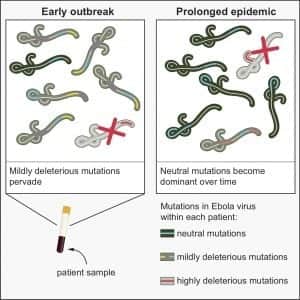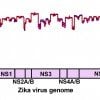 In a large collaboration between the Viral Hemorrhagic Fever Consortium, Kenema Government Hospital, Harvard University, Broad Institute, Tulane University, Edinburgh University, the CDC, USAMRIID, and others we have just published a paper in Cell detailing the epidemiology, transmission, and evolution of Ebola virus over seven months in Sierra Leone. The new study sequenced 232 new Ebola virus genomes, which were all released on NCBI and virological.org prior to publication. Adding important new insights into the paper we published in Science last year, this study shows that the outbreak is still sustained by a continues human-to-human transmission chain.
In a large collaboration between the Viral Hemorrhagic Fever Consortium, Kenema Government Hospital, Harvard University, Broad Institute, Tulane University, Edinburgh University, the CDC, USAMRIID, and others we have just published a paper in Cell detailing the epidemiology, transmission, and evolution of Ebola virus over seven months in Sierra Leone. The new study sequenced 232 new Ebola virus genomes, which were all released on NCBI and virological.org prior to publication. Adding important new insights into the paper we published in Science last year, this study shows that the outbreak is still sustained by a continues human-to-human transmission chain.
The data allowed us to elucidate transmission patterns between patients and show how the virus spread from Guinea into Sierra Leone, and from there across the region. This is suggestive of a sustained epidemic within individual countries driven by endemic transmission rather than by repeated introductions from neighboring countries. Interestingly, we also find evidence for evolutionary adaptation to the human host suggesting that selection across the genome is largely purifying, weeding out detrimental mutations over longer periods of time. An interesting exception to this is observed in the glycoprotein (the only protein on the outside of the viral particle) where we observe multiple nonsynomymous mutations within B cell epitopes. We believe that this selection signal is driven by within-host selection for immune escape over the course of human infection.
This study shows the strength of large collaborations linking epidemiological investigations with near-real-time sequencing of viral genomes to elucidate transmission patterns. This work is only possible when data are released quickly and freely – something which is unfortunately very rare in science. This clearly needs to change, and several labs have now started sharing data more openly, which can lead to important real-time tools such as NextFlu developed by Trevor Bedford and Richard Neher.
Abstract:
The 2013–2015 Ebola virus disease (EVD) epidemic is caused by the Makona variant of Ebola virus (EBOV). Early in the epidemic, genome sequencing provided insights into virus evolution and transmission and offered important information for outbreak response. Here, we analyze sequences from 232 patients sampled over 7 months in Sierra Leone, along with 86 previously released genomes from earlier in the epidemic. We confirm sustained human-to-human transmission within Sierra Leone and find no evidence for import or export of EBOV across national borders after its initial introduction. Using high-depth replicate sequencing, we observe both host-to-host transmission and recurrent emergence of intrahost genetic variants. We trace the increasing impact of purifying selection in suppressing the accumulation of nonsynonymous mutations over time. Finally, we note changes in the mucin-like domain of EBOV glycoprotein that merit further investigation. These findings clarify the movement of EBOV within the region and describe viral evolution during prolonged human-to-human transmission.
Links:
Paper in Cell (open access)
Previous paper in Science (open access)
Press release
Article/interview in The Scientist
Data releases on virological.org
NCBI release from Kenema Government Hospital (VHFC/Broad)
NCBI BioProject from Bo Lab (CDC)








